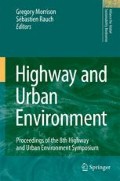A field-based microcosm method was used to determine whether sediments and soils that receive road runoff are toxic to indigenous aquatic macroinvertebrates present in the Greater Melbourne Area (GMA), Australia. Sediments and soils collected from areas draining three major highways were placed in 20 L microcosms along the littoral zone of a non-polluted wetland. Aquatic insects that emerge from the wetland randomly lay eggs in the microcosms. The occurrence and abundance of key taxa in these microcosms was measured to determine toxicity of the sediments. Several taxa responded in different ways to these sediments. The abundance of Paratanytarsus grimmii, Polypedilum leei, and Oxyethira columba significantly increased with increased concentrations of contaminants in sediments, and appeared to be most influenced by nutrient enrichment. The occurrence of Tanytarsus fuscithorax significantly declined with increased concentrations of zinc in surface waters that leached from sediments. Cricotopus albitarsis abundance was significantly higher in nutrient-enriched sediments, but significantly declined in high zinc concentrations in surface waters. There were significant negative correlations between the occurrence of Larsia albiceps, T. fuscithorax, and Procladius spp. and copper or total petroleum hydrocarbon (TPH) concentrations in sediments. This method provides unique information on the effects of contaminated soils and sediments on indigenous aquatic macroinvertebrates and can be used to determine the effectiveness of water sensitive urban designs in reducing sediment toxicity.
Access this chapter
Tax calculation will be finalised at checkout
Purchases are for personal use only
Preview
Unable to display preview. Download preview PDF.
References
Forster J (1993) The influence of atmospheric conditions and storm characteristics on roof runoff pollution with an experimental roof system. In: Proceedings of VIth international conference on urban storm drainage, Niagara Falls, Ontario, Canada, pp 411-416
Xanthopoulos C, Hahn HH (1990) Pollutants attached to particles from drainage areas. Sci Tot Environ 93:441-448
Ellis JB, Revitt DM (1991) Drainage for roads: control and treatment of highway runoff. Report NRA43804/MID.012. National Rivers Authority, Reading, UK
Pettigrove V (2006) Is catchment imperviousness a good indicator of ecosystem health? Proceedings of the highways and urbanization symposium
VicRoads (2005) Best strategy for treating stormwater at the roadside. Draft report. VicRoads design and landscape section, Kew, Victoria, Australia
Pitt RE (1995) Biological effects of urban runoff discharges. In: Herricks EE (ed.) Stormwater urban runoff, and receiving water systems, Lewis/CRC, Boca Raton, FL, pp 127-162
Pettigrove V, Hoffmann A (2005) A field-based microcosm method to assess the effects of polluted urban stream sediments on aquatic macroinvertebrates. Environ Tox Chem 24:170-180
Pitt R (1999) Receiving water and other impacts. In: Heany JP, Pitt R, Field R (eds.) Innovative urban wet-weather flow management systems. National risk management research laboratory, Office of Research and Development, US Environment Protection Agency, EPA/600/R-99/029. Chapter 4
U S Environment Protection Agency (1994) Methods for the determination of metals in environmental samples - supplement 1. Report No. EPA/600/R-94-111. USEPA, Cincinnati, OH, USA
Australian and New Zealand Environment and Conservation Council and Agri-culture and Resource Management Council of Australia and New Zealand (2000) National water quality management strategy, Australian and New Zealand guidelines for fresh and marine water quality, vol. 1 - the guidelines
MacDonald DD, Ingersoll CG, Berger TA (2000) Development and evaluation of consensus-based sediment quality guidelines for freshwater ecosystems. Arch Environ Cont Tox 39:20-31
Pettigrove V, Hoffmann A (2005) Effects of long-chain hydrocarbon-polluted sediment on freshwater macroinvertebrates. Environ Tox Chem 24:2500-2508
Pearson TH, Rosenberg R (1978) Macrobenthic succession in relation to organic enrichment and pollution of the marine environment. Oceanogr Mar Biol Ann Rev 16:229-311
Nebeker AV, Cairns MA, Wise CM (1984) Relative sensitivity of Chironomus tentans life stages to copper. Environ Tox Chem 3:151-158
Gauss JD, Woods PE, Winner RW, Skillings JH (1985) Acute toxicity of copper to three life stages of Chironomus tentans as affected by water hardness-alkalinity. Environ Pollut 37:149-157
Author information
Authors and Affiliations
Editor information
Editors and Affiliations
Rights and permissions
Copyright information
© 2007 Springer
About this paper
Cite this paper
Pettigrove, V., Marshall, S., Ryan, B., Hoffmann, A. (2007). A field microcosm method to determine the impact of sediments and soils contaminated by road runoff on indigenous aquatic macroinvertebrates. In: Morrison, G.M., Rauch, S. (eds) Highway and Urban Environment. Alliance For Global Sustainability Bookseries, vol 12. Springer, Dordrecht. https://doi.org/10.1007/978-1-4020-6010-6_34
Download citation
DOI: https://doi.org/10.1007/978-1-4020-6010-6_34
Publisher Name: Springer, Dordrecht
Print ISBN: 978-1-4020-6009-0
Online ISBN: 978-1-4020-6010-6
eBook Packages: Earth and Environmental ScienceEarth and Environmental Science (R0)

